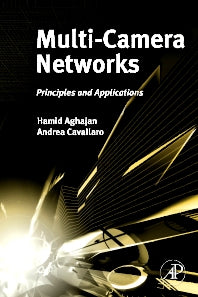Freshly Printed - allow 10 days lead
Couldn't load pickup availability
Multi-Camera Networks
Principles and Applications
The definitive reference on this important, emerging topic with applications in security and environmental monitoring
Hamid Aghajan (Edited by), Andrea Cavallaro (Edited by)
9780123746337, Elsevier Science
Hardback, published 17 June 2009
624 pages
23.4 x 19 x 3.4 cm, 1.42 kg
This book is the definitive reference in multi-camera networks. It gives clear guidance on the conceptual and implementation issues involved in the design and operation of multi-camera networks, as well as presenting the state-of-the-art in hardware, algorithms and system development. The book is broad in scope, covering smart camera architectures, embedded processing, sensor fusion and middleware, calibration and topology, network-based detection and tracking, and applications in distributed and collaborative methods in camera networks. This book will be an ideal reference for university researchers, R&D engineers, computer engineers, and graduate students working in signal and video processing, computer vision, and sensor networks. Hamid Aghajan is a Professor of Electrical Engineering (consulting) at Stanford University. His research is on multi-camera networks for smart environments with application to smart homes, assisted living and well being, meeting rooms, and avatar-based communication and social interactions. He is Editor-in-Chief of Journal of Ambient Intelligence and Smart Environments, and was general chair of ACM/IEEE ICDSC 2008. Andrea Cavallaro is Reader (Associate Professor) at Queen Mary, University of London (QMUL). His research is on target tracking and audiovisual content analysis for advanced surveillance and multi-sensor systems. He serves as Associate Editor of the IEEE Signal Processing Magazine and the IEEE Trans. on Multimedia, and has been general chair of IEEE AVSS 2007, ACM/IEEE ICDSC 2009 and BMVC 2009.
Preface
Introduction
Part I: Multi-Camera Calibration and Topology
1. Multiview Geometry for Camera Networks
2. Multiview Calibration Synchronization and Dynamic Scene Reconstruction
3. Actuation-assisted Localization of Distributed Camera Sensor Networks
4. Building an Algebraic Topological Model of Wireless Camera Networks
5. Optimal Placement of Multiple Visual Sensors
6. Optimal Visual Sensor Network Configuration
Part II: Active and Heterogeneous Camera Networks
7. Collaborative Control of Active Cameras in Large-Scale Surveillance
8. Pan-Tilt-Zoom Camera Networks
9. Multi-modal Data Fusion Techniques and Applications
10. Spherical Imaging in Omni-directional Camera Networks
Part III: Multi-View Coding
11. Video Compression for Camera Networks: a Distributed Approach
12. Distributed Compression in Multi-Camera Systems
Part IV: Multi-Camera Human Detection, Tracking, and Pose Analysis
13. On-line Learning a Person Detector by Co-Training from Multiple Cameras
14. Real-time 3D Body Pose Estimation
15. Multi-Person Bayesian Tracking with Multiple Cameras
16. Statistical Pattern Recognition for Multi-Camera Detection, Tracking and Trajectory Analysis
17. Object Association across Multiple Cameras
18. Video Surveillance using a Multi-Camera Tracking and Fusion System
19. Composite Event Detection in Multi-Camera and Multi-Sensor Surveillance Networks
Part V: Smart Camera Networks: Architecture, Middleware and Applications
20. Towards Pervasive Smart Camera Networks
21. Smart Cameras for Wireless Camera Networks: Architecture Overview
22. Embedded Middleware for Smart Camera Networks and Sensor Fusion
23. Cluster-Based Object Tracking by Wireless Camera Networks
Epilogue: Outlook
Subject Areas: Computer networking & communications [UT], Television technology [TJKV], Communications engineering / telecommunications [TJK]


